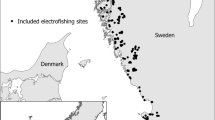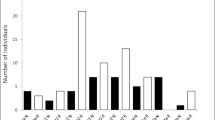Abstract
The red swamp crayfish, Procambarus clarkii, is a paradigmatic invader of freshwater systems. Several attempts have been made to mitigate its multiple impacts but none was successful. Among the different methods proposed, the use of the European eel (Anguilla anguilla) as an indigenous predator is promising but the available information about its predatory ability on crayfish is to date scanty. To fill this gap in knowledge, we ran three experiments in wetlands and irrigation ditches in Italy. The first experiment, in the laboratory, was aimed at quantifying the extent of predation by eels on crayfish, the second, in enclosures, the size classes of crayfish mainly preyed and the possible effect of the eels on P. clarkii behaviour, and the third, in the field, its ability to effectively reduce crayfish populations. Results showed that eels prey on small-sized or soft crayfish, attacking them from the back; an indirect effect was to reduce crayfish trophic activity, which in turn might increases crayfish mortality due to starvation and decreases impact on the community. However, as shown in the field, the use of eels should be appropriately calibrated to the context of application. Taken together, our results show that eels might be used as a complement to the traditional trap** method. However, additional studies are necessary to understand the adequate number of eels to be introduced and to develop appropriate methods for quantifying such effects.



Similar content being viewed by others
References
Aquiloni L, Gherardi F (2008) Evidence of female cryptic choice in crayfish. Biol Lett 4:163–165
Bartolini A (2007) La Riserva Naturale del Padule di Fucecchio. Dieci anni di gestione (1996-2006). Quaderni del Padule di Fucecchio n. 4. Centro di Ricerca, Documentazione e Promozione del Padule di Fucecchio
Behrendt A (1987) Don’t let eels steal your stock. Fish Farmer (Sept/Oct), 50–51
Blake MA, Hart PJB (1993) The behavioural responses of juvenile signal crayfish Pacifastacus leniusculus to stimuli from perch and eels. Freshw Biol 29:89–97
Blake MA, Hart PJB (1995a) The vulnerability of juvenile signal crayfish to perch and eel predation. Freshw Biol 33:233–244
Blake MA, Hart PJB (1995b) Habitat preferences and survival of juveniles signal crayfish, Pacifastacus leniusculus—the influence of water depth, substratum, predatory fish and gravid female fish. Freshw Crayfish 9:318–332
Butler MJ, Stein RA (1985) An analysis of the mechanisms governing species replacements in crayfish. Oecologia 66:168–177
Capelli GM, Munjal BL (1982) Aggressive interactions and resource competition in relation to species displacement among crayfish of the genus Orconectes. J Crust Biol 2:486–492
Clavero M, García-Berthou E (2005) Invasive species are a leading cause of animal extinctions. Trends Ecol Evol 20:110
Dekker W (2000) The fractal geometry of the European eel stock. ICES J Mar Sci 57:109–121
Dorn NJ, Wojdak JM (2004) The role of omnivorous crayfish in littoral communities. Oecologia 140:150–159
Elvira B, Nicola GG, Almodovar A (1996) Pike and red swamp crayfish: a new case on predator-prey relationship between aliens in central Spain. J Fish Biol 48:437–446
Frutiger A, Müller R (2002) Controlling unwanted Procambarus clarkii populations by fish predation. Freshw Crayfish 13:309–315
Garvey JE, Stein RA, Thomas HM (1994) Assessing how fish predation and interspecific prey competition influence a crayfish assemblage. Ecology 75:532–547
Gherardi F (2006) Crayfish invading Europe: the case study of Procambarus clarkii. Invited review paper. Mar Freshw Behav Physiol 39:175–191
Gherardi F (2007) Understanding the impact of invasive crayfish. In: Gherardi F (ed) Biological invaders in inland waters: profiles, distribution, and threats. Invading Nature: springer series in invasion ecology. Springer, Dordrecht, pp 507–542
Gherardi F, Acquistapace P (2007) Invasive crayfish in Europe: the impact of Procambarus clarkii on the littoral community of a Mediterranean lake. Freshw Biol 52:1249–1259
Gherardi F, Barbaresi S (2008) Feeding opportunism of the red swamp crayfish Procambarus clarkii, an invasive species. Freshw Crayfish 16:77–85
Hamrin SF (1987) Seasonal crayfish activity as influenced by fluctuating water levels and presence of a fish predator. Holoartic Ecol 10:45–51
Hartmann A, O’Neill D (1999) Fish predators and conspecifics influence molt location choice by red swamp crayfish, Procambarus clarkii (Girard). Freshw Crayfish 12:244–251
Hazlett BA, Acquistapace P, Gherardi F (2002) Differences in memory capabilities in invasive and native crayfish. J Crust Biol 22:439–448
Hein CL, Roth BM, Ives AR, Vander Zanden MJ (2006) Fish predation and trap** for rusty crayfish (Orconectes rusticus) control: a whole-lake experiment. Can J Fish Aquat Sci 63:383–393
Hein CL, Vander Zanden MJ, Magnuson JJ (2007) Intensive trap** and increased fish predation cause massive population decline of an invasive crayfish. Freshw Biol 52:1134–1146
Hirvonen H, Holopainen S, Lempiäinen N, Selin M, Tulonen J (2007) Sniffing the trade-off: effects of eel odours on nocturnal foraging activity of native and introduced crayfish juveniles. Mar Freshw Behav Physiol 40:213–218
Hobbs HH (1989) An illustrated checklist of the American crayfishes (Decapoda: Astacidae, Cambaridae and Parastacidae). Smithson Contrib Zool 480:1–236
Lodge DM, Kershner MW, Aloi JE, Covich AP (1994) Effects of an omnivorous crayfish (Orconectes rusticus) on a freshwater littoral food web. Ecology 75:1265–1281
Momot WT (1995) Redefining the role of crayfish in aquatic ecosystems. Rev Fish Sci 3:33–63
Moriarty C, Dekker W (1997) Management of the European Eel. Fish Bull (Dublin) 15:110
Nyström P (2002) Ecology. In: Holdich DM (ed) Biology of freshwater crayfish. Blackwell Science, Oxford, pp 192–235
Nyström P, Brönmark C, Granéli W (1996) Patterns in benthic food webs: a role for omnivorous crayfish? Freshw Biol 36:631–646
Owen SF (2001) Meeting energy budgets by modulation of behaviour and physiology in the eel (Anguilla anguilla L.). Comp Biochem Physiol A 128:631–644
Owen SF, Houlihan DF, Rennie MJ, Van Weerd JH (1998) Bioenergetics and nitrogen balance of the European eel (Anguilla anguilla) fed at high and low ration levels. Can J Fish Aquat Sci 55:2365–2375
Rach JJ, Bills TD (1989) Crayfish control with traps and largemouth bass. Progress Fish-Cult 51:157–160
Sala OE, Chapin FS III, Armesto JJ, Berlow R, Bloomfield J, Dirzo R, Huber-Sanwald E, Huenneke LF, Jackson RB, Kinzig A, Leemans R, Lodge D, Mooney HA, Oesterheld M, Poff NL, Sykes MT, Walker BH, Walker M, Wall DH (2000) Global biodiversity scenarios for the year 2100. Science 287:1770–1774
Scalici M, Gherardi F (2007) Structure and dynamic of an invasive population of the red swamp crayfish (Procambarus clarkii) in a Mediterranean Wetland. Hydrobiologia 583:309–319
Sokal RR, Rohlf FJ (1969) Biometry. Freeman, San Francisco
Stein RA (1977) Selective predation, optimal foraging, and the predator-prey interaction between fish and crayfish. Ecology 58:1237–1253
Stein RA, Magnuson JJ (1976) Behavioral response of crayfish to a fish predator. Ecology 57:751–761
Svärdson G (1972) The predatory impact of eel (Anguilla anguilla L.) on populations of crayfish (Astacus astacus L.). Report- Institute of Freshwater Research. Drottningholm 52:149–191
Vilà M, Basnou C, Pyšek P, Josefsson M, Genovesi P, Gollasch S, Nentwig W, Olenin S, Roques A, Roy D, Hulme PE, DAISIE partners (2009) How well do we understand the impacts of alien species on ecosystem services? a pan-European, cross-taxa assessment. Front Ecol Environ 8:135–144. doi:10.1890/080083
Acknowledgments
Experiments 1 and 2 were financed by the Province of Pistoia (Tuscany) and Experiment 3 by Consorzio di Bonifica Parmigiana Moglia-Secchia (Emilia-Romagna). The authors thank Dr F. Fagnani (Province of Pistoia), Ing. P. Zanetti, Dr. M. Fantesini, and Dr. M.T. Giglioli (Consorzio di Bonifica Parmigiana Moglia-Secchia) for their constant help and encouragement.
Author information
Authors and Affiliations
Corresponding author
Rights and permissions
About this article
Cite this article
Aquiloni, L., Brusconi, S., Cecchinelli, E. et al. Biological control of invasive populations of crayfish: the European eel (Anguilla anguilla) as a predator of Procambarus clarkii . Biol Invasions 12, 3817–3824 (2010). https://doi.org/10.1007/s10530-010-9774-z
Received:
Accepted:
Published:
Issue Date:
DOI: https://doi.org/10.1007/s10530-010-9774-z




